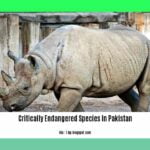Endangered Species in Pakistan: 10 Urgent Conservation Priorities highlights the pressing need to protect and preserve the diverse range of endangered species found in Pakistan. This article delves into the fascinating world of wildlife conservation and brings to light the critical status of ten species that are on the brink of extinction. With a focus on raising awareness and advocating for their survival, this piece aims to shed light on the urgent need for comprehensive conservation efforts to safeguard these iconic creatures and their fragile ecosystems. Join us as we explore the rich biodiversity of Pakistan and understand the challenges faced by these remarkable species.
Key Takeaways:
- Pakistan is home to a diverse range of wildlife, but many species are endangered and face the risk of extinction.
- The Markhor, a large Capra species native to Central Asia, Karakorum, and the Himalayas, is considered the national animal of Pakistan and has been listed as endangered since 2015.
- The Blind Dolphin, also known as the Indus Dolphin, is a rare species found in the rivers of Pakistan, particularly the Indus River, and is at high risk due to habitat destruction and pollution.
- The Ibex, also known as the Mountain Sheep or Markhor, is the national animal of Pakistan and is found in high altitude areas of the country.
- The Snow Leopard, a majestic cat species found in the mountainous regions of Pakistan, is listed as endangered due to habitat loss, poaching, and climate change.
- The Black Bear, found in northern regions of Pakistan, is an endangered species threatened by habitat loss and hunting.
- The Black-tailed Gazelle, also known as the Chinkara, is a critically endangered species in Pakistan threatened by hunting and habitat loss.
- The Musk Deer, found in the forests of Pakistan, is endangered due to hunting for its musk gland.
- Otters, including the Smooth-Coated Otter and the Eurasian Otter, are endangered species in Pakistan facing population decline because of habitat destruction and pollution of rivers and wetlands.
- The Urial, a wild sheep species found in the mountains of Pakistan, is at high risk due to habitat loss, hunting, and competition with domestic livestock.
- The Golden Mahseer, a fish species found in the rivers of Pakistan, is listed as critically endangered due to habitat destruction, overfishing, and pollution of rivers.
- Conservation efforts are crucial to protect these endangered species in Pakistan, including preserving their habitats and implementing measures against illegal hunting and poaching. The government should prioritize their preservation for future generations.
10 Endangered Species in Pakistan

Pakistan, a country blessed with diverse ecosystems, is home to a wide range of wildlife. However, many of these magnificent species are facing the threat of extinction. In this article, we will explore the ten endangered species in Pakistan that require urgent conservation efforts.
Markhor: The Pride of Pakistan
The markhor, a majestic wild goat, is considered the national animal of Pakistan. Found in Central Asia, the Karakorum, and the Himalayas, this iconic species has been listed as endangered since 2015. The markhor’s beautiful spiral horns and unique ability to climb steep mountain cliffs make it a symbol of resilience in the face of challenges. Unfortunately, illegal hunting and habitat degradation have greatly affected its population, making conservation efforts crucial for its survival.
Blind Dolphin: A Hidden Gem
The Indus River is home to the blind dolphin, also known as the Indus dolphin. This rare species, classified as vulnerable, faces numerous threats due to habitat destruction and pollution. With their adaptation to a life without vision, these fascinating creatures inhabit the murky waters, arousing curiosity about their survival skills. Protecting their habitat and ensuring clean waterways are vital for the conservation of this unique species.
Ibex: The King of Mountains
The ibex, often referred to as the mountain sheep or markhor, holds the title of the national animal of Pakistan. Thriving in high altitude regions, it symbolizes the resilience and adaptability required to survive in extreme environments. However, habitat loss and illegal hunting pose significant threats to this endangered species. Conservation efforts must focus on preserving their natural habitat and implementing strict measures against poaching.
Snow Leopard: The Silent Guardian
In the snow-capped mountains of Pakistan, the elusive and majestic snow leopard roams. This incredible cat species, listed as endangered, faces multiple challenges including habitat loss, poaching, and climate change. Its striking beauty and importance as a top predator make it a vital part of the ecosystem. Protecting the snow leopard’s habitat, enhancing anti-poaching measures, and raising awareness about its conservation are essential for its survival.
Black Bear: A Charismatic Forest Dweller
The black bear, found in the northern regions of Pakistan, is an endangered species facing the threat of habitat loss and hunting. With their captivating appearance and gentle demeanor, black bears play a crucial role in maintaining forest ecosystems. Efforts aimed at conserving their habitat and strictly regulating hunting activities can ensure their continued existence in the wild.
Black-tailed Gazelle: A Race Against Time
The critically endangered black-tailed gazelle, also known as the chinkara, faces the imminent threat of extinction. Hunting and habitat loss have driven this elegant species to the edge of survival. In the vast grasslands of Pakistan, the black-tailed gazelle once roamed freely, but urgent conservation measures are now necessary to protect their shrinking habitats and stop the decline of their population.
Musk Deer: A Fragile Beauty
The musk deer, a small species found in the forests of Pakistan, has been listed as endangered due to hunting for its musk gland, which is used in perfumes and traditional medicine. These enchanting creatures, with their distinct appearance, contribute to the biodiversity of Pakistan’s forests. Strict regulations against hunting and awareness campaigns about the importance of preserving this species are vital for its survival.
Otters: Guardians of Freshwater Ecosystems
The smooth-coated otter and the Eurasian otter, both endangered species, play a significant role in maintaining the balance of freshwater ecosystems. However, their populations have drastically declined due to habitat destruction and pollution of rivers and wetlands. Protecting their habitats, improving water quality, and educating communities about the importance of these aquatic guardians are essential for their survival.
Urial: A Mountain Dweller Under Threat
The urial, a wild sheep species found in the mountains of Pakistan, is facing the risk of extinction due to habitat loss, hunting, and competition with domestic livestock. Their captivating appearance and significance in maintaining mountain ecosystems highlight the need for immediate conservation measures. Preserving their natural habitats and implementing sustainable grazing practices can help secure their future.
Golden Mahseer: A Precious Aquatic Gem
The golden mahseer, a fish species found in the rivers of Pakistan, is critically endangered due to habitat destruction, overfishing, and pollution. Revered as an iconic sport fish, its existence reflects the health of the riverine ecosystems it inhabits. Protecting their habitats, enforcing fishing regulations, and raising public awareness about sustainable fishing practices are crucial for the survival of this magnificent species.
These ten endangered species emphasize the urgency of conservation efforts in Pakistan. Preserving their habitats, curbing illegal hunting and poaching, and raising awareness among communities are essential steps towards securing the future of these magnificent creatures for generations to come. Let us unite in our resolve to protect and cherish the rich biodiversity that Pakistan has been blessed with.
(End of Article)
Here are some fascinating articles about endangered birds, species, and wildlife in India:
10 Endangered Birds in India – Discover ten captivating birds that are at risk of extinction in India. Learn about their unique characteristics and the conservation efforts being made to protect them.
10 Endangered Species in India – Explore the incredible diversity of endangered species in India, from mammals to reptiles and everything in between. Find out why these species are in danger and what can be done to save them.
10 Endangered Species of Animals in India – Delve into the world of endangered animals in India and uncover the challenges they face in their natural habitats. Discover how initiatives are working tirelessly to ensure their survival for future generations.
10 Endangered Wildlife Species of India – Embark on a virtual journey to explore the awe-inspiring wildlife species of India that are teetering on the edge of extinction. Learn about the conservation efforts dedicated to preserving these precious creatures and their habitats.
Explore these links to deepen your understanding of the endangered birds, species, and wildlife in India. Together, we can make a difference in protecting our precious natural heritage.
Detailed Description of the First Endangered Species and Its Habitat
The Markhor, a majestic wild goat, is one of the endangered species in Pakistan that requires urgent conservation efforts. This fascinating creature faces the dual threats of illegal hunting and habitat degradation, which have pushed its population to dangerously low levels.
Habitat loss is a significant factor contributing to the decline of the Markhor. As human populations expand, the demand for land for agriculture, infrastructure development, and settlements increases. Consequently, the grazing grounds and rocky cliffs that these goats call home are being destroyed.
The Markhor’s habitat predominantly consists of mountainous regions with steep slopes, rocky cliffs, and sparse vegetation. These areas provide both shelter and abundant food sources for the species. However, due to the encroachment of human activities, including deforestation and land conversion, the Markhor’s habitat is diminishing, leaving them with limited space to thrive.
Illegal hunting is another significant threat faced by the Markhor. Poachers target these magnificent creatures for their impressive spiral horns, which are highly valued in the illegal wildlife trade. The demand for these horns, believed to have medicinal properties, has led to relentless hunting, putting the Markhor at risk of extinction. Additionally, the presence of firearms and increased accessibility to remote areas has escalated poaching activities.
To mitigate the threats faced by the Markhor and ensure their survival, urgent conservation measures are necessary. These efforts include:
Strict enforcement of anti-poaching laws and regulations: By strengthening law enforcement agencies, increasing patrolling efforts, and imposing severe penalties on poachers, we can deter illegal hunting and protect the Markhor.
Promotion of sustainable land-use practices: Encouraging eco-friendly agricultural techniques, responsible tourism, and reforestation initiatives can help minimize habitat degradation and provide sustainable livelihood options for local communities.
Establishment of protected areas and conservation corridors: Designating protected regions and creating corridors that connect different habitats can safeguard the Markhor’s population and ensure their genetic diversity.
Public awareness campaigns: Educating communities about the ecological importance of the Markhor and the negative consequences of illegal hunting can foster a sense of ownership and promote conservation efforts at the grassroots level.
The ongoing conservation efforts to protect the Markhor are crucial not only for the survival of this remarkable species but also for the preservation of the delicate mountain ecosystems they inhabit.
Discussion on the Conservation Efforts and Initiatives for the Species

As we strive to protect the endangered species of Pakistan, it is crucial to discuss the conservation efforts and initiatives in place to ensure their survival. Through collaborative efforts by scientists, researchers, conservation organizations, and local communities, progress has been made, but there is still much work to be done. In this article, we will explore the ongoing conservation initiatives and the importance of taking action to preserve these species and their habitats.
Conservation Efforts:
Protected Areas and National Parks: One of the key conservation efforts in Pakistan is the establishment and management of protected areas and national parks. These areas provide safe havens for endangered species by preserving their habitats and limiting human interference. Through strict regulations and monitoring, authorities work towards the conservation of species like the Markhor, Snow Leopards, and Ibex.
Habitat Restoration and Management: Recognizing the significance of habitat degradation in species decline, conservation initiatives focus on habitat restoration and management. This involves activities such as reforestation, combating deforestation, and combating soil erosion. By restoring and preserving the natural environments of endangered species, conservationists aim to secure their future.
Community-Based Conservation: Engaging local communities in conservation efforts is essential for long-term success. Conservation organizations collaborate with communities living near endangered species habitats, raising awareness about the importance of conservation and offering sustainable alternatives for livelihoods. This approach helps create a sense of ownership, empowering communities to protect the species they share their lands with.
Conservation Breeding Programs: To increase the population numbers of critically endangered species, conservation breeding programs have been initiated. These programs involve carefully managed captive breeding to reintroduce individuals into the wild. For example, successful breeding programs have helped save subspecies like the Rhino, once widespread but now confined to national parks and reserves.
Research and Monitoring: Scientific research forms the foundation of effective conservation initiatives. Conservationists conduct field surveys, monitor population trends, and study the behavior and ecology of endangered species. This research helps identify key threats, understand their biology, and develop targeted conservation strategies.
Initiatives for the Species:
Anti-Poaching Measures: Poaching remains a significant threat to endangered species in Pakistan. Efforts are being made to combat poaching through increased law enforcement, stricter penalties, and educational campaigns to raise awareness about the negative impacts of wildlife trafficking.
Public Awareness Campaigns: Education and awareness play a vital role in rallying support for conservation efforts. Through public awareness campaigns, the importance of protecting endangered species is conveyed to a broader audience. These campaigns aim to inspire a sense of responsibility and encourage individuals to take action in their daily lives to safeguard biodiversity.
Collaboration with International Organizations: Pakistan collaborates with international organizations such as the International Union for Conservation of Nature (IUCN) and the World Wildlife Fund (WWF) to benefit from their expertise, resources, and global networks. This collaboration helps bring international attention to the conservation needs of Pakistani species and ensures access to global best practices and funding opportunities.
Policy Development and Advocacy: Strong policies and advocacy efforts are crucial for species protection. Conservation organizations work closely with governments to develop and implement policies that safeguard endangered species and their habitats. These policies ensure the enforcement of regulations and promote sustainable practices in industries that may impact endangered species.
Collaboration between Multiple Stakeholders: Conservation efforts are most successful when various stakeholders work together. Governments, NGOs, local communities, scientists, and researchers collaborate to share knowledge, expertise, and resources. This joint effort maximizes the impact of conservation initiatives and ensures a comprehensive approach to species preservation.
Key Takeaways:
- Conservation efforts in Pakistan focus on protected areas, habitat restoration, community engagement, breeding programs, and scientific research.
- Anti-poaching measures and public awareness campaigns are essential to mitigate threats and garner support.
- Collaboration with international organizations and policy development play significant roles in species conservation.
- Multi-stakeholder collaboration enables comprehensive and effective conservation initiatives.
Sources:
– National Wildlife Federation. Website Link
– World Wildlife Fund. Website Link
Explanation of the Threats Faced by the Species and Potential Solutions
The threats faced by endangered species in Pakistan are significant and require urgent attention. Human activities and environmental factors contribute to the decline in population and jeopardize the survival of these species. It is crucial to understand these threats in order to develop effective conservation strategies. In this article, we will explore the main threats faced by endangered species in Pakistan and potential solutions to address them.
Habitat Destruction: A Major Threat
One of the primary threats to endangered species in Pakistan is habitat destruction. With the expanding human population and increasing demand for resources, natural habitats are being destroyed at an alarming rate. Deforestation, urbanization, and unsustainable agricultural practices lead to the loss and fragmentation of habitats, leaving species without the necessary resources to survive. This loss of habitat affects the entire ecosystem and disrupts the delicate balance of biodiversity.
Potential Solutions
– Strict implementation and enforcement of laws and regulations to prevent illegal deforestation and habitat destruction.
– Promoting sustainable land-use practices, such as reforestation and afforestation initiatives.
– Establishing protected areas and nature reserves to conserve and restore critical habitats.
– Collaborating with local communities and stakeholders to raise awareness and promote sustainable livelihoods that do not rely on destructive practices.
Illegal Hunting and Poaching: Draining Species Populations
Illegal hunting and poaching pose a significant threat to the survival of endangered species in Pakistan. Many species, such as the majestic Markhor and the national animal Ibex, are targeted for their valuable horns, hides, or body parts. This unsustainable exploitation puts immense pressure on already dwindling populations, pushing them closer to extinction.
Potential Solutions
– Strengthening law enforcement and implementing stricter penalties for wildlife trafficking and poaching.
– Investing in community-based conservation initiatives that provide alternative sources of income and discourage illegal hunting.
– Conducting awareness campaigns to educate the public about the consequences of wildlife trade and the importance of conserving endangered species.
– Collaborating with international organizations and neighboring countries to combat cross-border trafficking.
Climate Change: A Growing Threat
Climate change poses a significant threat to endangered species in Pakistan. Rising temperatures, changing rainfall patterns, and melting glaciers are transforming habitats and disrupting ecosystems. Species like the Snow Leopard, which rely on cold and snowy mountainous regions, are particularly vulnerable to the impacts of climate change. These changes can lead to habitat loss, changes in food availability, and increased susceptibility to diseases.
Potential Solutions
– Reducing greenhouse gas emissions through the adoption of cleaner energy sources and sustainable practices.
– Enhancing habitat connectivity and creating corridors to enable species to migrate and adapt to changing climatic conditions.
– Conducting research and monitoring programs to assess the impacts of climate change on endangered species and develop targeted conservation strategies.
– Promoting climate change education and advocacy to raise awareness about the need for urgent action.
Pollution and Habitat Degradation: Undermining Species Survival
Pollution and habitat degradation are significant threats to endangered species in Pakistan. Human activities, such as industrial pollution and agricultural runoff, contaminate water bodies and degrade freshwater ecosystems. This pollution adversely affects species like otters and blind dolphins, which depend on clean and healthy aquatic habitats.
Potential Solutions
– Implementing strict industrial and agricultural pollution control measures.
– Regulating the use of harmful chemicals and promoting sustainable farming practices.
– Investing in water treatment and conservation efforts to restore and protect freshwater ecosystems.
– Conducting regular monitoring and assessment of pollution levels to identify and address sources of contamination.
Invasive Species: Disrupting Native Ecosystems
Invasive species pose a threat to endangered species in Pakistan by outcompeting native species and disrupting ecosystems. These non-native species, introduced through human activities, can rapidly multiply, leading to the decline or extinction of indigenous plants and animals. The delicate balance of ecosystems is disturbed, and the survival of endangered species is further threatened.
Potential Solutions
– Establishing robust monitoring and early warning systems to detect and manage invasive species.
– Developing and implementing eradication and control programs to remove invasive species.
– Promoting scientific research on invasive species and their impacts to inform effective management strategies.
– Strengthening biosecurity measures to prevent the introduction and spread of invasive species.
Key Takeaways:
– Habitat destruction, illegal hunting, climate change, pollution, and invasive species are major threats to endangered species in Pakistan.
– Conservation efforts should focus on habitat protection, law enforcement, community engagement, and sustainable practices.
– Strict implementation of laws, awareness campaigns, and collaboration with international organizations are essential in addressing these threats.
– Climate change mitigation, pollution control, and invasive species management are crucial for ensuring the survival of endangered species in Pakistan.
– Preservation of biodiversity is essential for ecosystem stability and human well-being.
Sources:
– World Wildlife Fund – Problems Facing Endangered Species
– National Geographic Society – Wildlife Conservation
FAQ
Q1: What is the Markhor and why is it endangered?
A1: The Markhor is a large Capra species native to Central Asia, Karakorum, and the Himalayas. It is considered the national animal of Pakistan. The Markhor has been listed as endangered on the Red List of endangered animals by the International Union for Conservation of Nature (IUCN) since 2015. Factors contributing to its endangered status include habitat loss, hunting, and competition with domestic livestock.
Q2: What are the main threats facing the Blind Dolphin in Pakistan?
A2: The Blind Dolphin, also known as the Indus Dolphin, is a rare species found in the rivers of Pakistan, particularly the Indus River. It is classified as vulnerable and is at high risk due to habitat destruction and pollution. Industrial waste and agricultural runoff contribute to the pollution of the Indus River, which negatively impacts the survival of the Blind Dolphin.
Q3: Why is the Snow Leopard endangered in Pakistan?
A3: The Snow Leopard is a majestic cat species found in the mountainous regions of Pakistan. It is listed as endangered due to habitat loss, poaching, and climate change. The high altitude habitats that the Snow Leopard depends on are being affected by human activities such as infrastructure development and grazing. Additionally, illegal hunting for its fur and body parts poses a significant threat to its survival.
Q4: What actions are being taken to protect the Urial in Pakistan?
A4: The Urial is a wild sheep species found in the mountains of Pakistan. It is at high risk due to habitat loss, hunting, and competition with domestic livestock. To protect the Urial, conservation efforts focus on habitat preservation, implementing stricter regulations on hunting, and promoting sustainable grazing practices for domestic livestock. These measures aim to reduce human-wildlife conflict and ensure the survival of the Urial population.
Q5: How is the Golden Mahseer being conserved in Pakistan?
A5: The Golden Mahseer is a fish species found in the rivers of Pakistan. It is listed as critically endangered due to habitat destruction, overfishing, and pollution of rivers. Conservation efforts for the Golden Mahseer involve implementing fishing regulations, raising awareness about its conservation status, and promoting sustainable fishing practices. Additionally, initiatives are in place to restore and protect the rivers where the Golden Mahseer population resides.
- Discover the Borough of Frenchtown, NJ: A Delaware River Town Blending History, Art & Nature - November 22, 2024
- Discover Clarks Grove, MN: A Small Town with a Big Heart - November 22, 2024
- Califon Borough, NJ: A Small Town with a Big Heart (and Rich History) - November 22, 2024





![Saving the [Example of Endangered Species in Pakistan]: A Call to Action for Conservation Efforts example-of-endangered-species-in-pakistan_2](https://www.lolaapp.com/wp-content/uploads/2023/12/example-of-endangered-species-in-pakistan_2-150x150.jpg)







